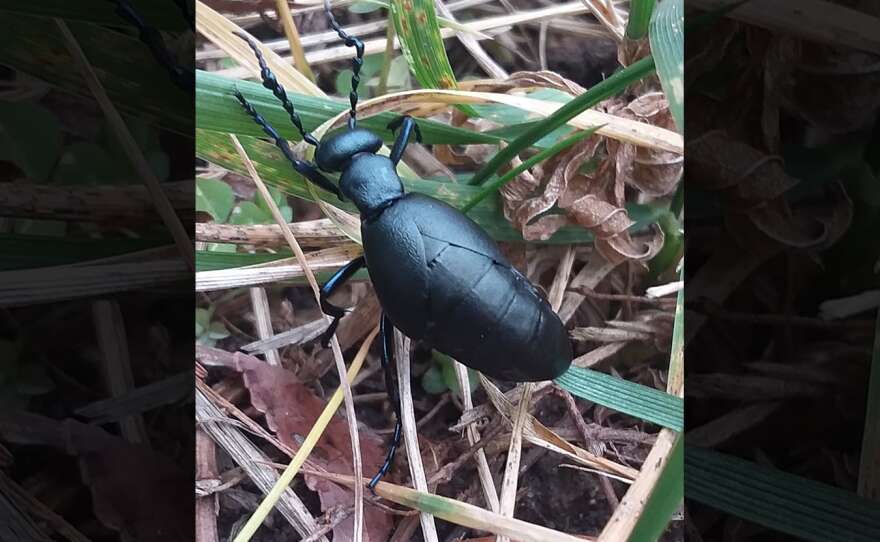Dr. Art Evans, entomologist, and VPM radio producer Steve Clark discuss the beautiful Meloe Oil Beetle which emerges in late fall each year on the Sesame Street lawn.
Steve Clark: I'm Steve Clark with Dr. Art Evans, entomologist, and this is What’s Bugging You. Meloe time.
Art Evans: It is.
Clark: They're so beautiful. We’ve found them three out of four years.
Evans: It is like seeing old friends. I enjoy going out here at the station and looking for them. And it’s at a time of year when there isn't much else out, so it's always a treat to see them. And they’re such a large, spectacular looking beast too.
Clark: They have this leathery sort of skin. It’s a soft-body insect.
Evans: They're very soft-bodied, and after they die, they kind of shrivel up.
Clark: Sad.
Evans: Yeah, it’s sad to see them deflate. [laughing] So what is it that fascinates you about oil beetles?
Clark: The history that I have with it is when I found one on the side of a building, I called you and you said, “I'll be right there.”
Evans: I don't see them very often, just because I'm not usually out and about at a time when they are. I'm trapped in the classroom or busy trying to wrap other things up; I'm not walking around. But I still remember clearly when you sent me that photograph, and I said, “Find it. Capture it.” And then of course it was gone. And so we . . .
Clark: We found them.
Evans: We found them. We started walking big circles around the station until we came across the spot.
Clark: And that's the spot that we go back to every year. This year, I took a nice photograph. I got it on the first attempt. I've been showing it to the people around the station and explaining what this beetle is. They're fascinated with my limited narrative of the thing, but they think it's awfully beautiful.
Evans: Well, it's a nice photo too, and it clearly shows it being a male. [laughing] You can tell by the kink in the antennae. The males will crawl up on the females’ backs, and then they will use these modified articles of their antennae to clasp the antennae of the female as they prepare to mate. They have this very elaborate courtship behavior.
Clark: They also have this behavior that I relate to. The folks that see my photograph, and I tell them about the cantharidin that exudes from the elbows, I guess, of the legs. That can be pretty caustic.
Evans: Right, these beetles engage in a defensive behavior called “reflex bleeding”. And they actually release hemolymph, which is their blood, from their knee joints, and in the case of blister beetles, it contains a dose of cantharidin, which is a very caustic chemical that causes blistering. Oil beetles belong to a much larger group of insects called blister beetles.
Clark: Now you're talking about the blood. Is there something special about the blood of these insects that allows them to live in this colder climate when everyone else has gone away for the year?
Evans: I don't know. I don't think they're out and about when it's freezing. So there are some insects that have their own version of antifreeze in their bodily fluids that protects them from freezing. But I don't know that these beetles fall into that category. I suspect when it gets really cold, they're going to be down in the soil beyond the reach of the frost.
Clark: Well, I'm really happy that we got to go out and see the Meloe at least one more time.
Evans: Well, in good numbers too. I mean, there were several dozen out there. I hope nothing ever happens to that spot. Maybe we should put a little sign out there sometime saying, you know, “Caution, oil beetle crossing.” [laughing]
Clark: Dr. Art Evans is a research associate at the Virginia Museum of Natural History. You’ll find photos and audio and links to the museum and Art’s Facebook page at vpm.org/bugs.
Dr. Arthur V. Evans teams up with VPM Radio producer Steve Clark for a weekly feature, “What’s Bugging You?,” which airs during NPR’s Morning Edition. The program takes its name from another of Evans’ books “What’s Bugging You – A Fond Look at the Animals We Love to Hate.”
Tune in each Tuesday at 8:45 a.m. or at 5:44 p.m. on VPM News


